
Conondale National Park is 130 km north of Brisbane in the Sunshine Coast Hinterland near the town of Conondale in the south east Queensland bioregion. The park covers an area of 35,648 hectares protecting large areas of subtropical rainforest, woodlands, wet and dry sclerophyll forest including Queensland's tallest tree. The park contains areas of regenerating forest which have been previously logged; areas of forest plantations also border the park. The park is currently managed by the Queensland Government under the Nature Conservation Act 1992.

Garcinia is a genus of flowering plants in the family Clusiaceae native to Asia, America, Australia, tropical and southern Africa, and Polynesia. The number of species is disputed; the Kew Gardens recognise up to 400. Commonly, the plants in this genus are called saptrees, mangosteens, garcinias, or monkey fruit.
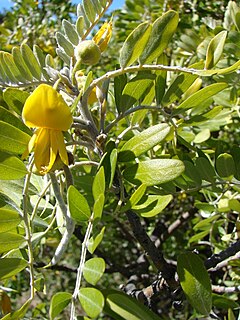
Sophora is a genus of about 45 species of small trees and shrubs in the pea family Fabaceae. The species are native to southern Asia, Australasia, various Pacific islands, western South America, the western United States, Florida and Puerto Rico. The generic name is derived from sophera, an Arabic name for a pea-flowered tree.

Sophora toromiro, commonly known as toromiro, is a species of flowering tree in the legume family, Fabaceae, that is endemic to Easter Island. Heavy deforestation had eliminated most of the island's forests by the first half of the 17th century, and the once common toromiro became rare and ultimately extinct in the wild in the 1960s.

Commiphora wightii, with common names Indian bdellium-tree, gugal, guggul, gugul, or mukul myrrh tree, is a flowering plant in the family Burseraceae, which produces a fragrant resin called gugal, guggul or gugul, that is used in incense and vedic medicine. The species is native to southern Pakistan and western India. It prefers arid and semi-arid climates and is tolerant of poor soil.
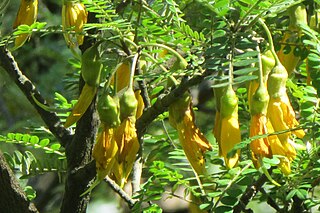
Sophora fernandeziana is a species of flowering plant in the family Fabaceae, that is endemic to the Juan Fernández Islands of Chile. It is threatened by habitat loss.
Sophora mangarevaensis is a species of flowering plant in the family Fabaceae, that is endemic to French Polynesia.
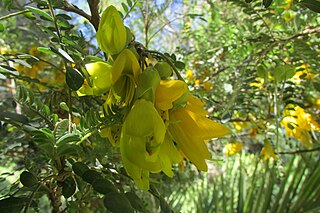
Sophora masafuerana is a species of flowering plant in the family Fabaceae, that is endemic to the Juan Fernández Islands of Chile. It is threatened by habitat loss.
Sophora raivavaeensis is a species of flowering plant in the family Fabaceae, that is endemic to French Polynesia.
Sophora rapaensis is a species of flowering plant in the family Fabaceae, that is endemic to French Polynesia.
Sophora saxicola is a species of flowering plant in the family Fabaceae, that is endemic to Jamaica.
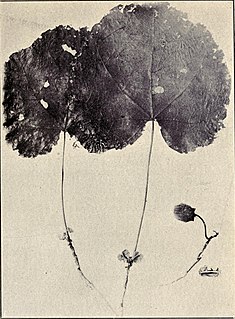
Hibiscadelphus hualalaiensis is a species of flowering plant in the mallow family, Malvaceae, that is endemic to the Big Island of Hawaii. The last known plant died in 1992, making it most likely extinct in the wild; any remaining plants are threatened by habitat loss. It inhabits dry and mixed mesic forests on the slopes of Hualālai at elevations of 915–1,020 m (3,002–3,346 ft). Associated plants include ʻōhiʻa lehua, lama, māmane, naio, ʻālaʻa, pāpala, ʻaiea, poʻolā, and Kikuyu Grass. H. hualalaiensis is a small tree, reaching a height of 5–7 m (16–23 ft) and trunk diameter of 30 cm (12 in).
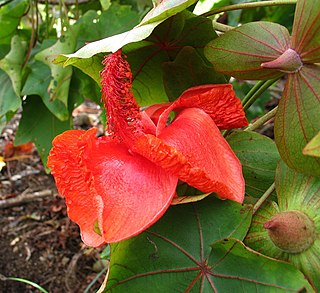
Kokia drynarioides, commonly known as Hawaiian tree cotton, is a species of flowering plant in the mallow family, Malvaceae, that is endemic to the Big Island of Hawaii. It inhabits dry forests at elevations of 455–1,915 m (1,493–6,283 ft). Associated plants include ʻāheahea, ʻaʻaliʻi, hala pepe, wiliwili, uhiuhi, kōlea, ʻaiea, kuluʻī, ʻālaʻa, ʻohe kukuluāeʻo, māmane, and maua. It is threatened by habitat loss and competition with invasive species, such as Fountain Grass.
Garcinia wightii is a species of flowering plant in the family Clusiaceae. It is found only in India.
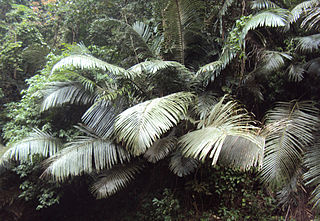
Arenga wightii is a species of flowering plant in the family Arecaceae. It is found almost exclusively in India. It is threatened by habitat loss.
Dracaena konaensis, synonym Pleomele hawaiiensis, the Hawaiʻi hala pepe, is a rare species of flowering plant that is endemic to the island of Hawaiʻi in the state of Hawaii.

The great Maui rail or great Maui crake is an extinct bird species from Maui, one of two flightless rails which survived on Maui until people arrived in 150 C.E.
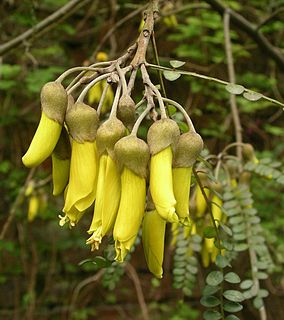
Sophora tetraptera, commonly known as large-leaved kōwhai, grows naturally only in the central east of the North Island in New Zealand. S. tetraptera has larger more widely spaced leaves than the other seven species of kōwhai.

The Hawaiʻi ʻelepaio, also Hawaiian ʻelepaio, is a monarch flycatcher found on the Big Island of Hawaii. Until 2010, all three ʻelepaio species, the Kauaʻi ʻelepaio, the Oʻahu ʻelepaio and this species were considered conspecific.













